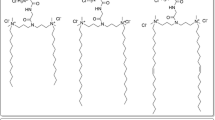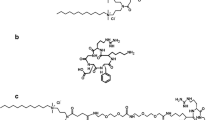Abstract
Diquaternary ammonium-based gemini surfactants have been investigated widely as nonviral gene delivery systems. These unique cationic lipids have versatility in their chemical structure, show relatively low toxicity, are able to compact genetic material (pDNA, RNA) into nano-sized lipoplexes, and can be easily produced. In addition, the gemini surfactants show significant improvement in the transfection activity and biocompatibility compared to other cationic lipids used as nonviral gene delivery agents. The successful applications of gemini surfactant-based lipoplexes as topical gene delivery systems in animal models indicate their potential as noninvasive carriers for genetic immunization, theranostic agents, and in other gene therapy treatments. Detailed physicochemical characterization of gemini surfactant lipoplexes is a key factor in terms of formulation optimization and elucidation of the cellular uptake and stability of the lipoplexes system. In this chapter, we describe in detail different formulation methods to prepare gemini surfactant lipoplexes and comprehensive physicochemical characterization. In addition, we illustrate general protocols for in vitro evaluations.
Access this chapter
Tax calculation will be finalised at checkout
Purchases are for personal use only
Similar content being viewed by others
References
Jin L, Zeng X, Liu M, Deng Y, He N (2014) Current progress in gene delivery technology based on chemical methods and nano-carriers. Theranostics 4:240–255
Singh J, Mohammed-Saied W, Kaur R, Badea I (2013) Nanoparticles in gene therapy: from design to clinical applications. Rev Nanosci Nanotechnol 2:275–299
Menger FM, Littau C (1991) Gemini-surfactants: synthesis and properties. J Am Chem Soc 113:1451–1452
Rosen MJ, Tracy DJ (1998) Gemini surfactants. J Surfactant Deterg 1:547–554
Badea I, Verrall R, Baca-Estrada M et al (2005) In vivo cutaneous interferon-γ gene delivery using novel dicationic (gemini) surfactant–plasmid complexes. J Gene Med 7:1200–1214
Badea I, Wettig S, Verrall R, Foldvari M (2007) Topical non-invasive gene delivery using gemini nanoparticles in interferon-γ-deficient mice. Eur J Pharm Biopharm 65:414–422
Badea I, Virtanen C, Verrall R, Rosenberg A, Foldvari M (2011) Effect of topical interferon-γ gene therapy using gemini nanoparticles on pathophysiological markers of cutaneous scleroderma in Tsk/+ mice. Gene Ther 19:978–987
Garcia MT, Kaczerewska O, Ribosa I, Brycki B, Materna P, Drgas M (2016) Biodegradability and aquatic toxicity of quaternary ammonium-based gemini surfactants: effect of the spacer on their ecological properties. Chemosphere 154:155–160
Wasungu L, Scarzello M, van Dam G et al (2006) Transfection mediated by pH-sensitive sugar-based gemini surfactants; potential for in vivo gene therapy applications. J Mol Med 84:774–784
Kim B-K, Doh K-O, Bae Y-U, Seu Y-B (2011) Synthesis and optimization of cholesterol-based diquaternary ammonium gemini surfactant (chol-gs) as a new gene delivery vector. J Microbiol Biotechnol 21:93–99
Pérez L, Pinazo A, Pons R, Infante M (2014) Gemini surfactants from natural amino acids. Adv Colloid Interf Sci 205:134–155
Yang P, Singh J, Wettig S, Foldvari M, Verrall RE, Badea I (2010) Enhanced gene expression in epithelial cells transfected with amino acid-substituted gemini nanoparticles. Eur J Pharm Biopharm 75:311–320
Singh J, Yang P, Michel D, E Verrall R, Foldvari M, Badea I (2011) Amino acid-substituted gemini surfactant-based nanoparticles as safe and versatile gene delivery agents. Curr Drug Deliv 8:299–306
Al-Dulaymi MA, Chitanda JM, Mohammed-Saeid W et al (2016) Di-peptide-modified gemini surfactants as gene delivery vectors: exploring the role of the alkyl tail in their physicochemical behavior and biological activity. Am Assoc Pharm Scient J 18:1168–1181
Al-Dulaymi M, Michel D, Mohammed Saeid W et al (2016) Novel peptide-modified gemini surfactants as gene carriers structure activity relationship, physicochemical characterizations and mass spectrometric dissociation behaviour. American Association of Pharmaceutical Scientists Annual Meeting and Exhibition, Denver, CO
Singh J, Michel D, Getson HM, Chitanda JM, Verrall RE, Badea I (2015) Development of amino acid substituted gemini surfactant-based mucoadhesive gene delivery systems for potential use as noninvasive vaginal genetic vaccination. Nanomedicine 10:405–417
Singh J, Michel D, Chitanda JM, Verrall RE, Badea I (2012) Evaluation of cellular uptake and intracellular trafficking as determining factors of gene expression for amino acid-substituted gemini surfactant-based DNA nanoparticles. J Nanobiotechnol 10:7
Prabha S, Arya G, Chandra R, Ahmed B, Nimesh S (2014) Effect of size on biological properties of nanoparticles employed in gene delivery. Artif Cell Nanomed Biotechnol 44:1–9
Fröhlich E (2012) The role of surface charge in cellular uptake and cytotoxicity of medical nanoparticles. Int J Nanomedicine 7:5577
Ma B, Zhang S, Jiang H, Zhao B, Lv H (2007) Lipoplex morphologies and their influences on transfection efficiency in gene delivery. J Control Release 123:184–194
Toby BH, Von Dreele RB (2013) GSAS-II: the genesis of a modern open-source all purpose crystallography software package. J Appl Crystallogr 46:544–549
Hanwell MD, Curtis DE, Lonie DC, Vandermeersch T, Zurek E, Hutchison GR (2012) Avogadro: an advanced semantic chemical editor, visualization, and analysis platform. J Chem 4:17
Frisch MJ, Trucks GW, Schlegel HB, Scuseria GE, Robb MA, Cheeseman JR, Scalmani G, Barone V, Mennucci B, Petersson GA et al (2013) Gaussian 09, revision D.01. Gaussian, Wallingford, CT
Gratton SE, Ropp PA, Pohlhaus PD et al (2008) The effect of particle design on cellular internalization pathways. Proc Natl Acad Sci 105:11613–11618
Foged C, Brodin B, Frokjaer S, Sundblad A (2005) Particle size and surface charge affect particle uptake by human dendritic cells in an in vitro model. Int J Pharm 298:315–322
Zantl R, Baicu L, Artzner F, Sprenger I, Rapp G, Rädler JO (1999) Thermotropic phase behavior of cationic lipid-DNA complexes compared to binary lipid mixtures. J Phys Chem B 103:10300–10310
Dauty E, Remy J-S, Blessing T, Behr J-P (2001) Dimerizable cationic detergents with a low cmc condense plasmid DNA into nanometric particles and transfect cells in culture. J Am Chem Soc 123:9227–9234
Harkins WD, Jordan HF (1930) Surface tension by the ring method. Science 72:73–75
Carpena P, Aguiar J, Bernaola-Galván P, Carnero Ruiz C (2002) Problems associated with the treatment of conductivity–concentration data in surfactant solutions: simulations and experiments. Langmuir 18:6054–6058
Israelachvili JN, Mitchell DJ, Ninham BW (1976) Theory of self-assembly of hydrocarbon amphiphiles into micelles and bilayers. J Chem Soc Faraday Trans 72:1525–1568
Kumar V (1991) Complementary molecular shapes and additivity of the packing parameter of lipids. Proc Natl Acad Sci 88:444–448
Moghaddam B, Mcneil SE, Zheng Q, Mohammed AR, Perrie Y (2011) Exploring the correlation between lipid packaging in lipoplexes and their transfection efficacy. Pharmaceutics 3:848–864
Burgess DJ, Duffy E, Etzler F, Hickey AJ (2004) Particle size analysis: American Association of Pharmaceutical Scientists workshop report, cosponsored by the Food and Drug Administration and the United States Pharmacopeia. Am Assoc Pharm Scient J 6:23–34
Pérez-Rodríguez M, Prieto G, Rega C, Varela LM, Sarmiento F, Mosquera V (1998) A comparative study of the determination of the critical micelle concentration by conductivity and dielectric constant measurements. Langmuir 14:4422–4426
Garcia-Mateos I, Mercedes Velazquez M, Rodriguez LJ (1990) Critical micelle concentration determination in binary mixtures of ionic surfactants by deconvolution of conductivity/concentration curves. Langmuir 6:1078–1083
Koenig BW, Gawrisch K (2005) Specific volumes of unsaturated phosphatidylcholines in the liquid crystalline lamellar phase. Biochim Biophys Acta 1715:65–70
Tanford C (1980) The hydrophobic effect: formation of micelles and biological membranes, 2nd edn. Wiley, New York
Author information
Authors and Affiliations
Corresponding author
Editor information
Editors and Affiliations
Rights and permissions
Copyright information
© 2019 Springer Science+Business Media, LLC, part of Springer Nature
About this protocol
Cite this protocol
Al-Dulaymi, M., Mohammed-Saeid, W., El-Aneed, A., Badea, I. (2019). Peptide-Modified Gemini Surfactants: Preparation and Characterization for Gene Delivery. In: Weissig, V., Elbayoumi, T. (eds) Pharmaceutical Nanotechnology. Methods in Molecular Biology, vol 2000. Humana, New York, NY. https://doi.org/10.1007/978-1-4939-9516-5_14
Download citation
DOI: https://doi.org/10.1007/978-1-4939-9516-5_14
Published:
Publisher Name: Humana, New York, NY
Print ISBN: 978-1-4939-9515-8
Online ISBN: 978-1-4939-9516-5
eBook Packages: Springer Protocols




